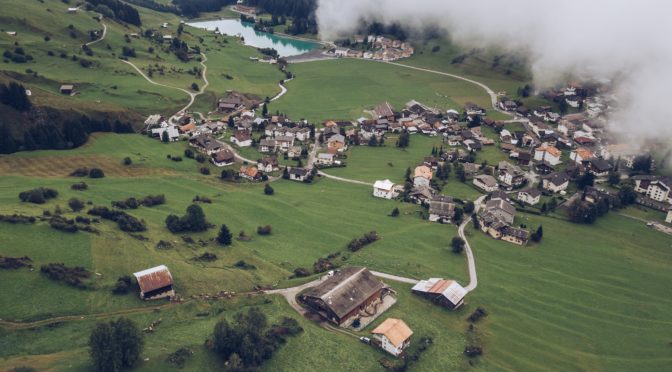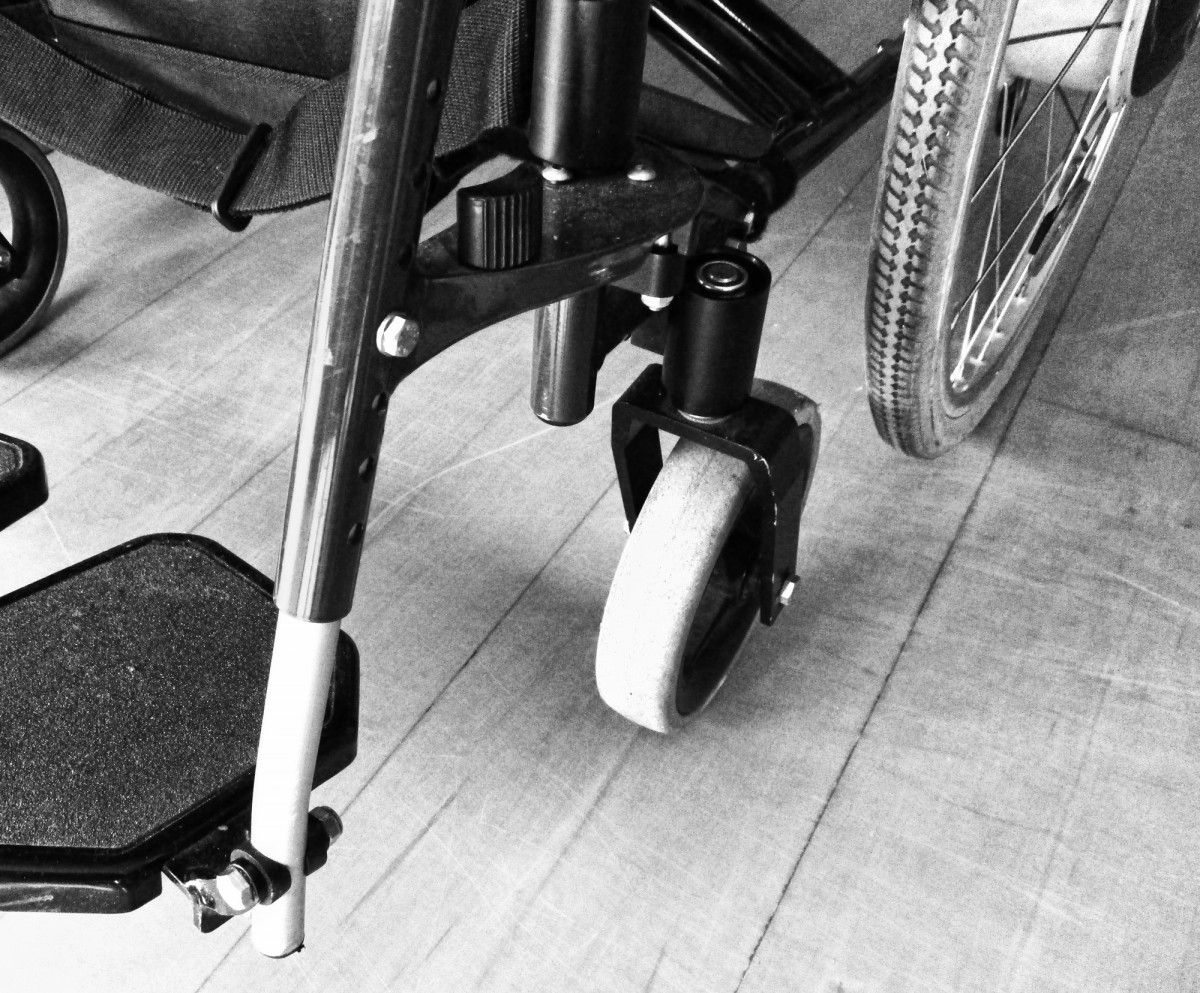An Eco-critical Perspective of Building Communities via the Face of the Other
by Samuel Moynihan
This essay employs the work of Lawrence Buell, Marc Augé,and Emmanuel Levinas to examine Agnes Varda’s Visages Villageswithin an eco-critical context. The text shows that Visages Villagesand its makers work to create communities by transforming the liminal spaces, from symptomatic to modernity , into places that are connected with the people who inhabit them. This connection is facilitated by street art that amounts to an encounter with the “face of the other” described by Levinas.
Introduction
Visages Villagesfollows the collaboration between filmmaker Agnes Varda and street-artist-turned-activist JR. Together they wander the French countryside exploring forgotten corners and photographing the people they meet. These photos are blown up to monumental size and pasted in unusual places, displaying a whimsical worldview that the artists share.
A train car can become a sequence of eyes gazing back at the viewer. An alleyway can become a hallway of local faces made larger than life. This project works to eliminate the boundaries between individuals by transforming liminal and isolated spaces into places that are bound to human faces. By transforming a forgotten space into a surprise confrontation with the face of a neighbor, JR and Varda create areas in which individuals are forced into an unexpected confrontation with philosopher Emmanuel Levinas’s foundation for ethical relations: the “face of the other,” which in turn, builds communities.
The foundation of Visages Villagesrests upon the interplay between space and place, as laid out by ecocritical writer Lawrence Buell in Writing for an Endangered World: Literature, Culture, and Environment in the U.S. and Beyond. Space can be defined in the geographical terms, or the purely descriptive aspects of a location, whereas place includes the geographical but transcends it through its human dimension. Place is the human narrative intersecting space, being told through cultural associations, memory, experience, and relationships to other spaces (Augé, 77-78).
As JR and Varda travel through the French countryside, they document the people and places they encounter. French anthropologist Marc Augé might argue that the act of travel perhaps precludes the traveler from experiencing their surroundings as places. According to Augé, the “plurality of places” overwhelms the senses. The journey, and each stage upon it, becomes defined by the waypoints. The inability of the spectator to observe and experience the totality of a place transforms it into a mere “passageway.”
This is not entirely the case in Visages Villages. For JR and Varda , there doesn’t seem to be an itinerary. Instead of contrived visits to unknown locales, they guide each other, leading the other to small French villages, farms, and settlements in which they possess friends, memories, and stories. This nostalgic approach to travel injects each area with an experiential human dimension. Though JR may introduce Varda to a farmer previously unknown to her, she is able to share her own stories of past friends who live just down the road from her new acquaintance. Additionally, this community-centered approach demonstrates the filmmakers’ care and respect for each place’s inhabitants.
The structure of their journey prevents the alienation of individuals that Augé claims is symptomatic of super-modernity. Augé argues that the structures of super-modernity promote isolation, rendering place into non-place. “As anthropological places create the organically social, so non-places create solitary contractuality.”
This is particularly true of places that may be encountered on a journey. The highway, the airport, or the strange streets of an unfamiliar city can prompt a sense of detachment as the individual’s relationship to them is marked solely by transit. While non-places create anonymity, anthropological places are defined by community and identity. Keith Basso describes them thusly: “Places possess a marked capacity for triggering acts of self-reflection, inspiring thoughts about who one presently is, or memories of who one used to be, or musings on who one might become.” These acts of self-reflection create identities that are associated with the particular place.
This self-reflection can be seen to some extent in this film, as JR and Varda ride aboard a train from one destination to the next. This is one moment in which Augé’s discussion of the traveler’s inability to absorb the landscape seems to apply, and it occurs where one would it expect it to: during uninterrupted travel between destinations. Despite the self-reflection present between destinations, the rapidly shifting landscape prevents the travelers from even creating a sense of place while traveling.
But this alienation is not present within the destinations themselves. This is owed partially to JR and Varda’s own history within each village, as well as their efforts in each community to associate with its residents. By meeting locals within each village, Varda and JR imbue each place with relationships, meaning, and most importantly, human narratives. Their footage isn’t just another travel documentary that merely showcases landscapes and artifacts to a human story. The reason for the title becomes apparent.
Through interviews, meet and greets, and the guerilla-style photography provided by JR, the filmmakers give a human visage to geographical space. Douglas Barton Christie describes why this approach feels so satisfying to the viewer: “While we do want and need a sober and honest record of place, we want more than this. We want to understand who we are in this place, what it means for us, why it matters” (Christie, 350).
JR and Varda manage to situate and explain the context of places within each location, describing associations and identities of the place. Often, this is done through Varda’s reminiscences of the past. For example, the two visit a lake she had previously visited one summer with Jean-Luc Godard and Anna Karina. Additionally, JR provides his own justification for their presence in certain areas. He explains to Varda that the dockworkers represent a kind of village, hence the filmmaker’s presence among them. The relationships between space and identity are further reinforced by editing.
In one scene, JR’s pushing of the wheelchair-riding Varda through the Louvre serves as a reference to Godard’s Bande a Partas well as represents a bridge for Varda to explore her own longtime friendship with Godard. The Louvre, which stands in as a super-modern non-place in Augé ’s ideation, is transformed into a human space through the endowment of memory, history, and the relationship between Godard and Varda. The association is made clear as the film offers Varda’s reflections on their friendship, their history, and her attempt to reconnect with Godard. In this way the film explores the relationship between spaces, history, and identity.
Liminal Spaces
The major transformative thrust of the film revolves around the artwork of young JR. Traveling in a mobile studio, JR photographs the inhabitants of each location he visits. He then uses these portraits in his large-scale guerilla art, wherein the images are enlarged and pasted onto some structure. Often, these structures exist as liminal spaces, or the in-between spaces, such as alleyways, train cars, shipping containers, stairwells, or cisterns.
The liminal spaces represent the cost of modernity. To create large cities, to feed consumers, etc., we have created these non-places. The shipping dock Le Havre represents globalization, new ideas, new technology, and new people. All of this results in progress, but who gets left behind? It’s the working poor, such as the dockworkers themselves. This disillusionment and alienation of the working class is apparent in France, especially with the rise of politicians like Marine LePen.
Other groups are included in Varda’s view of the forgotten. Despite the popularity of the #MeToo movement, French actresses, like Catherine Deneuve, believe that sleeping with a producer or director is essentially part of the job of an actress. The transformation of these shipping containers is a form of activism that seeks to use non-place to build identity, community, and history in the area surrounding it. The dockworkers’ union is known for its radicalism and public protests, yet they lack representation for women.
As a result, JR and Varda focus not on men and union members, but on the wives who stand behind their husbands while working in and around the dock themselves. They choose to photograph the women, blow their images up to gargantuan size, and paste the images onto the sides of shipping containers stacked like towers. The end result is a colossal image that brings attention to the women who work in and around the docks while still appealing to the pre-established identity of the workers and their families. The piece communicates the importance of women without overshadowing the political struggles of the dockworkers. Through this work, the non-space wherein workers receive goods becomes a temporary symbol of identity for the workers and their families, uniting the community with a common symbol.
In one example of liminality being converted into activist spaces, JR and Varda photograph a woman named Jeanine, who is the last inhabitant of an old mining community. Though she is alone, she refuses to leave the neighborhood, as the home she occupies represents her own identity and former community. Her family lived and died in that neighborhood, along with multiple generations of miners. As a tribute to her determination, the artists pasted a mural-sized portrait of her face across the front wall of her house, as well as larger-than-life full-body cutouts of several miners. These murals portray a personal and cultural identity that can be attributed to the area.
Again, while the primary mural brings attention to this lone woman who refuses to leave the neighborhood, the installation as a whole still works to bring attention to the working class who formerly inhabited the neighborhood alongside her. By allowing the portraits to speak for themselves, they work with the established identity and narrative of the community, rather than subverting it. Passersby are able to see the figures from a distance and recall the workers who formerly inhabited the area, as well as the woman who continues to.
For the documentary, JR and Varda devote time to learning the history of the neighborhood by interviewing former residents and former miners and even tracking down the original of an old photograph of the neighborhood’s miners, of which Varda keeps a postcard-sized print. This documentarian aspect works with JR’s art to depict an identity and history associated with the physical location of his piece. Though the piece is ephemeral and will fade within the coming weeks or months, the portraits and the interest generated in the community will perhaps create a narrative that will outlast JR’s pasting. The contrast between the temporary murals and the enduring narratives shown in the film is an aim of Varda’s, which she has spoken to in interviews: “What we wanted really is to be the go-between [for] the people we filmed and you…so I feel, I hope that now you know Jeanine, you know the mailman, you know the workers in the chemical factory, you know the dockworkers…and their wives. You know them now. I hope you won’t forget them.”
The temporality of the medium (wheat paste and paper) resolves a tension that exists between place and non-place in this project. By creating a work of art in an oft forgotten space, JR and Varda risk creating new landmarks. If their work was permanent, then tourism, maintenance, and ownership of the work could spawn new narratives around the subjects, narratives which may not necessarily belong to or match the subjects’ own experience.
This not only creates an ethical dilemma surrounding ownership of stories, but it also undermines the work itself. JR’s purpose in graffiti has always been to directly present his work to the public. Though his popularity has provided him with a platform, permanent exhibitions might encourage government or private stewards to maintain and protect the art, essentially acting as gatekeepers that could exclude the public from experiencing it. JR described his resistance to galleries in a 2011 TED talk: “I mean, the city is the best gallery I could imagine. I would never have to make a book and present it to a gallery and let them decide if my work was, you know, nice enough to show it to people. I would control it directly with the public.” By placing these works in public areas, the art directly engages the public to strengthen the community.
In another instance, JR and Varda explore the village Pirou-Plage, which was only partially developed before it was abandoned and left empty. Left behind are the skeletal remains of half-built houses and abandoned paths. In this project, JR and Varda invite locals from the surrounding area and former residents of the settlement to be interviewed and photographed. They use portraits taken of these visitors to decorate the abandoned development. Unlike Jeanine, whose murals serve to bring awareness to her identity and neighborhood’s history, this project exists almost solely for the individuals who visited the site that day.
The clear exposure to the elements will also ensure that the work fades quickly. The temporality of the work embraces the temporality of the village it is being placed in, built and abandoned before most of the houses were finished. The medium works with the environment to depict the situation of the former residents. In a place that has been abandoned before it was inhabited, the ephemerality of its inhabitance is perhaps the only thing its former residents share. The one-day visit to the site and the temporary artwork displaying the former residents allow the site to act as a physical representation of their shared identity without transforming the site itself into a permanent installation and an ironic monument to non-place.
This sort of revitalization of non-place is expressly described by JR within the film. As JR and Varda walk through an abandoned and ruined village, they discuss their intentions with neighbors and visitors to the abandoned area. “We hope to inhabit, to re-inhabit, this place where life has left, using faces and energy, if only for a day.” In this way, their work is activism that seeks to rejuvenate the forgotten spaces of modernity and facilitate empathy for their subjects within the viewers of their work.
The source of the empathy and identification that results from the transformation wrought by JR and Varda can be explained as an encounter with Emmanuel Levinas’ “Other” as described in Totality and Infinity, the author’s exploration of ethics. Because JR and Varda’s work leans heavily toward portraiture, their pieces serve as mementos which remind the viewer of human presence in and around these liminal spaces. This is the foundation their activism rests upon.
Throughout Levinas’ work exists an idea of the face as a manifestation of the other and the self. An encounter with another prompts introspection and serves as a foundation for
Levinas’ system of ethics. For Levinas, the fundamental origin of human interaction is the response to the face of another. The presence of an “other” necessitates an understanding of the self and vice versa. For every subject, there needs be a viewer. This relationship is evoked through JR’s placement of portraits and human eyes across the landscape.
By placing an image of forgotten or marginalized individuals in spaces such as alleys, train cars, or buildings, JR and Varda force viewers to engage with a member of their community. If the viewer has the necessary context, such as the identity of the subject or their occupation, the portrait can function as a socially charged message. This can be seen in JR’s early work around the suburbs of Paris, as well as in the mostly empty neighborhood of miners still occupied by Jeanine. Regardless of whether or not the viewer is acquainted with the portrait provided, the work can still instill a sense of community in the mind of the viewer, as they are naturally prompted to identify a fellow human in the face of the subject.
“The way in which the other presents himself, exceeding the idea of the other in me, we here name face…The face of the Other at each moment destroys and overflows the plastic image it leaves me, the idea existing to my own measure…It expresses itself,” (Levinas, 50). Levinas describes the non-essentiality of explanation when a viewer is confronted with the face of the other. This nearly renders context irrelevant for JR’s work, as the mere visage of the subject creates a sense of empathy in the viewer.
These works and the artists’ close attention to and respect for identity provide individuals and communities a platform to wordlessly communicate with and encounter each other. The communication and activism occur in spaces where individuals are typically isolated. By taking these non-places that typically lack identity and humanity and adorning them with human faces, the non-place is temporarily transformed into a place steeped in identity that facilitates empathy and community between individuals.
Works Cited
Augé, Marc. Non-Places: Introduction to an Anthropology of Supermodernity. Verso, 2009
Balsom, Erika. Cinema Scope, issue 74, 2018. Pp. 70
Basso, Keith. Wisdom Sits in Places,University of New Mexico Press. 1996 pp. 107
Bergo, Bettina, “Emmanuel Levinas”, The Stanford Encyclopedia of Philosophy (Fall 2017
Edition), Edward N. Zalta (ed.),
URL=<https://plato.stanford.edu/archives/fall2017/entries/levinas/>.
Buell, Lawrence. Writing for an Endangered World. Harvard University Press. 2001
Christie, Douglas Burton, Place Making as Contemplative Practice. Anglican Theological
Review, volume 91, issue 3, 2009. Pp.347
Film Society of Lincoln Center. “Agnès Varda and JR | ‘Faces Places’ Q&A | NYFF55.” https://www.youtube.com/watch?v=u2r_NF1NB3Q.10/20/2017. Web.
Khatchadourian, Raffi. “In the Picture: An Artist’s Global Experiment to Help People Be Seen”, The New Yorker, November 28, 2011 issue.
Levinas, Emmanuel. Totality and Infinity: an Essay on Exteriority. Duquesne University Press, 1969.
TED. “Use art to turn the world inside out | JR.” https://www.youtube.com/watch?v=0PAy1zBtTbw.3/4/2011 Web.
Visages Villages. Varda, Agnes, JR. Cohen Media Group. 2017 Film




